Australia, known for its breathtaking coastline and vibrant surfing culture, is a paradise for beachgoers and surfers alike. With its vast expanse of shoreline and diverse surf breaks, the country boasts numerous beaches offering some of the world’s largest waves. From the rugged coasts of Victoria to the pristine shores of Western Australia, the land down under is home to some of the most enormous surf breaks in the world.
What is Big Wave Surfing?
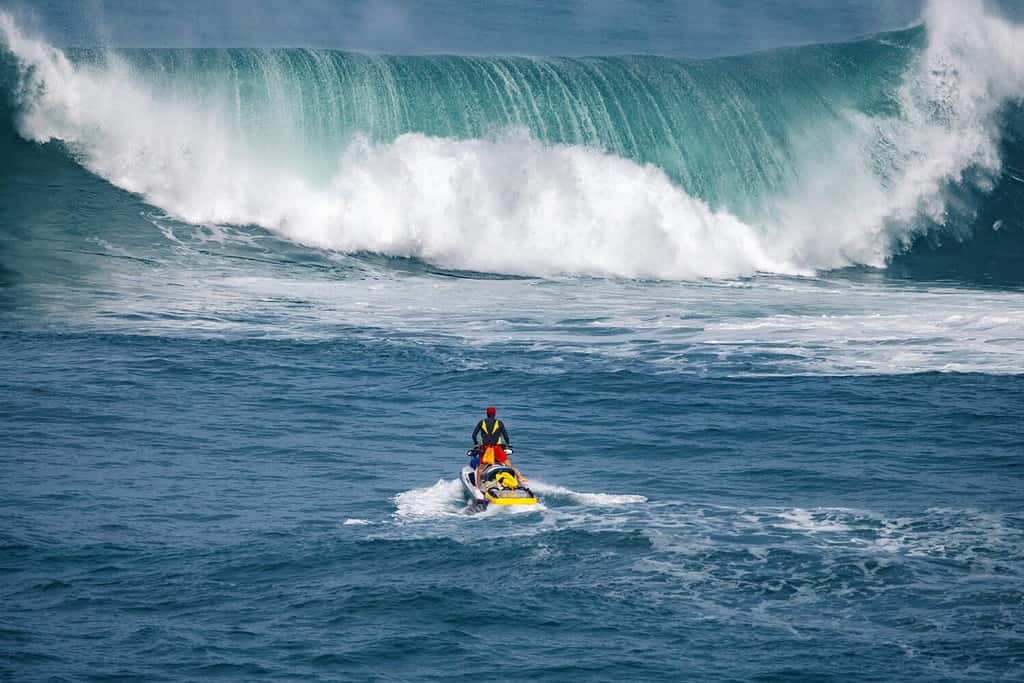
Rescue lifeguard in the ocean in front of a big wave searching for surfers.
©Nikita M production/Shutterstock.com
Big wave surfing is where the surfer rides waves at least 20 feet high or, in most cases, higher. Sebastian Steudtner holds the world record for the most giant wave ever surfing at 86 feet, equivalent to surfing an eight-story building. Additionally, experienced surfers engage in this thrilling sport by either paddling into these enormous waves or lifeguards tow them into them using specialized boards called “guns.” The choice of board size depends on various factors, including the wave size and the surfer’s technique for reaching the wave. Generally, a larger and longer board enables the rider to paddle sufficiently to catch the wave and offers excellent stability. However, in Big Wave Surfing, it is impossible to use a longer board, and surfers generally use boards 7 feet or shorter for better maneuverability and surfing speed.
Below is a list of the beaches with the largest waves in Australia. Please note that surf conditions can vary depending on the time of year, weather patterns, and other factors. It’s always important to check local surf reports and adhere to safety guidelines when surfing in Australia.

1. Bells Beach, Victoria
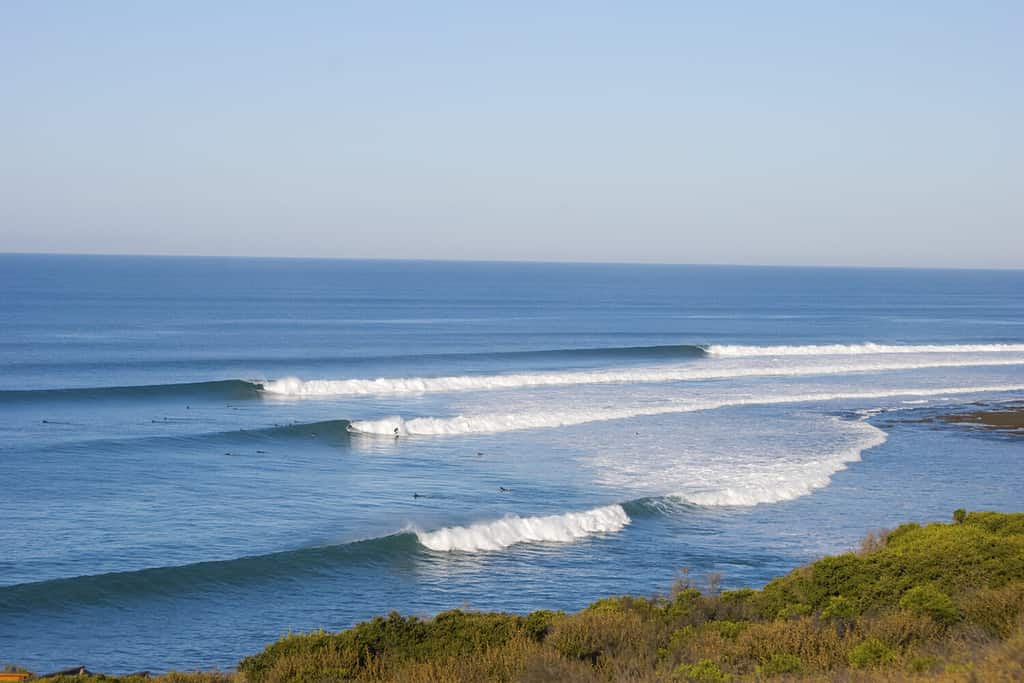
Surfers spend a lot of time at Bells Beach, Australia.
©Camila Se/Shutterstock.com
Bells Beach is located along the Great Ocean Road, about 100 kilometers southwest of Melbourne. This beach is part of the Surf Coast Shire and lies near Torquay, Australia’s surfing capital. Bells Beach is one of Australia’s most iconic surf spots. It is famous for its powerful waves and is home to the annual Rip Curl Pro surfing competition. It is common for wave faces to exceed 10 to 15 feet or even larger. Some of the largest waves ever ridden at Bells Beach have reached 20 feet or more heights during intense storm swells. People know the waves for their power, speed, and hollow barrels, making it a favorite spot for experienced surfers looking for a challenge.
People know the main surf break at Bells Beach as the Bells Bowl. It is a world-class right-hand point break that produces long, powerful waves that can reach impressive heights. The waves break over a rock shelf, creating a challenging and fast ride. The Bells Bowl is most active during the southern hemisphere winter months (April to September) when large swells generated by Southern Ocean storms make their way to the coast.
Surfing Events at Bells Beach
Bells Beach holds an important place in the world of professional surfing. It is home to the annual Rip Curl Pro, the longest-running professional surfing competition in the world. The event is part of the World Surf League (WSL) Championship Tour and attracts top surfers from around the globe. Bells Beach has a rich surfing culture and history. It gained international recognition after being featured in the iconic surf movie “The Endless Summer” in 1966. Since then, it has become synonymous with Australian surfing and has hosted numerous memorable sports moments. The beach and its surroundings exude a laid-back vibe and a deep respect for the ocean. It has been a gathering place for surfers, fostering a strong sense of community and camaraderie among enthusiasts.
2. Margaret River, Western Australia
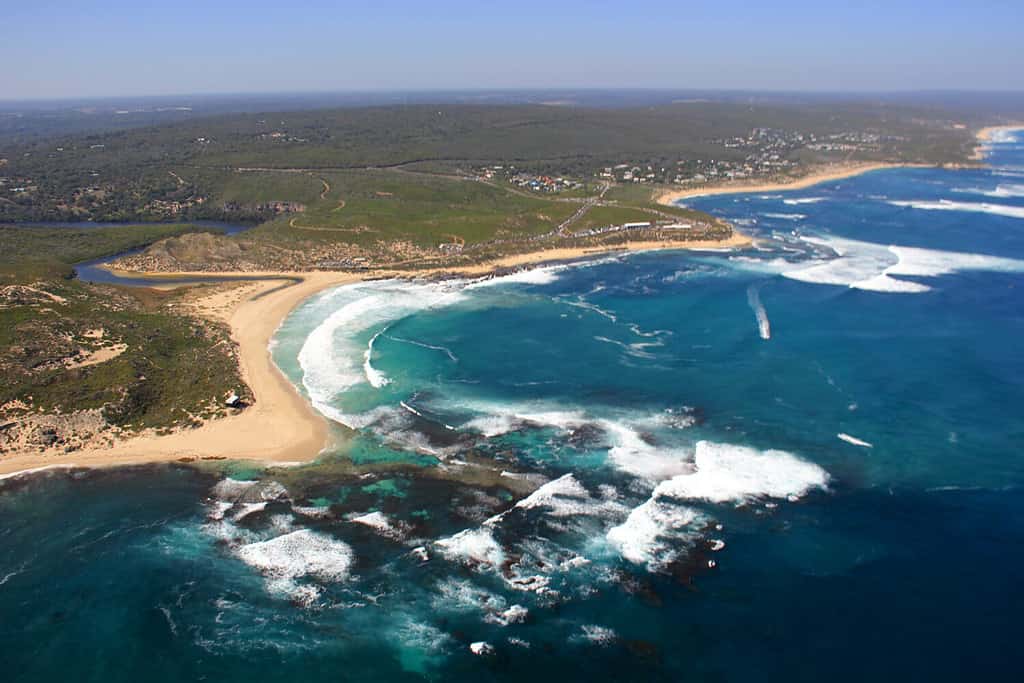
Aerial The Box, Surfers Point, Margaret River, Western Australia.
©Lella B/Shutterstock.com
People know the Margaret River region for its world-class surf breaks. Surfers flock to Surfers Point, Main Break, and The Box to experience the country’s most giant and challenging waves. Surfers Point is the famous point break at Margaret River, known for its consistent and powerful waves, making it a favorite among experienced surfers. The waves there can reach heights of 10 to 15 feet or more during peak swells. The main break, located south of Surfers Point, is a reef break that attracts professional surfers worldwide. Winter brings mighty Southern Ocean swells to the region, generating giant waves exceeding 20 feet in height.
The Margaret River Pro, part of the World Surf League (WSL) Championship Tour, is one of the most significant events on the professional surfing calendar. This competition occurs at Main Break, attracting top surfers who compete in challenging conditions for world title points.
3. Snapper Rocks, Queensland

Perfect waves hitting the Gold Coast, Snapper Rocks.
©Visual Collective/Shutterstock.com
Situated on the Gold Coast, near the border between Queensland and New South Wales, people recognize the large break surf known as the “Superbank.” It calls the Quiksilver Pro surfing event home and people flock to it for producing long, hollow waves that can get quite large. Snapper Rocks is a rocky point break that extends into the ocean, creating a natural sandbar that helps shape and enhance the quality of the waves. Snapper Rocks is famous for its high-quality waves, considered some of the best on the Gold Coast. People know the break for producing long, hollow, and fast waves, providing ideal conditions for tube riding. The waves at Snapper Rocks can reach heights of 4 to 6 feet on average, and during peak swells, they can exceed 8 to 10 feet or even larger.
The best time to surf at Snapper Rocks is during the winter months (April to September) when the region experiences more consistent swells generated by Southern Ocean storms. However, waves can be surfable throughout the year, with varying conditions depending on the season and weather patterns. Snapper Rocks is an integral part of the famous Superbank, a long, sand-bottomed point break that extends from Snapper Rocks through Greenmount Beach and into Kirra. The sandbar formations, natural currents, and topography have created an incredible wave-riding experience. The long rides offered by the Superbank make it a dream destination for surfers who enjoy linking multiple turns and maneuvers along the wave face.
Snapper Rocks is home to the Quiksilver Pro Gold Coast, an annual World Surf League (WSL) Championship Tour event. This high-profile competition brings together the world’s top professional surfers to showcase their skills in the mighty waves of Snapper Rocks.
4. Cape Solander, New South Wales
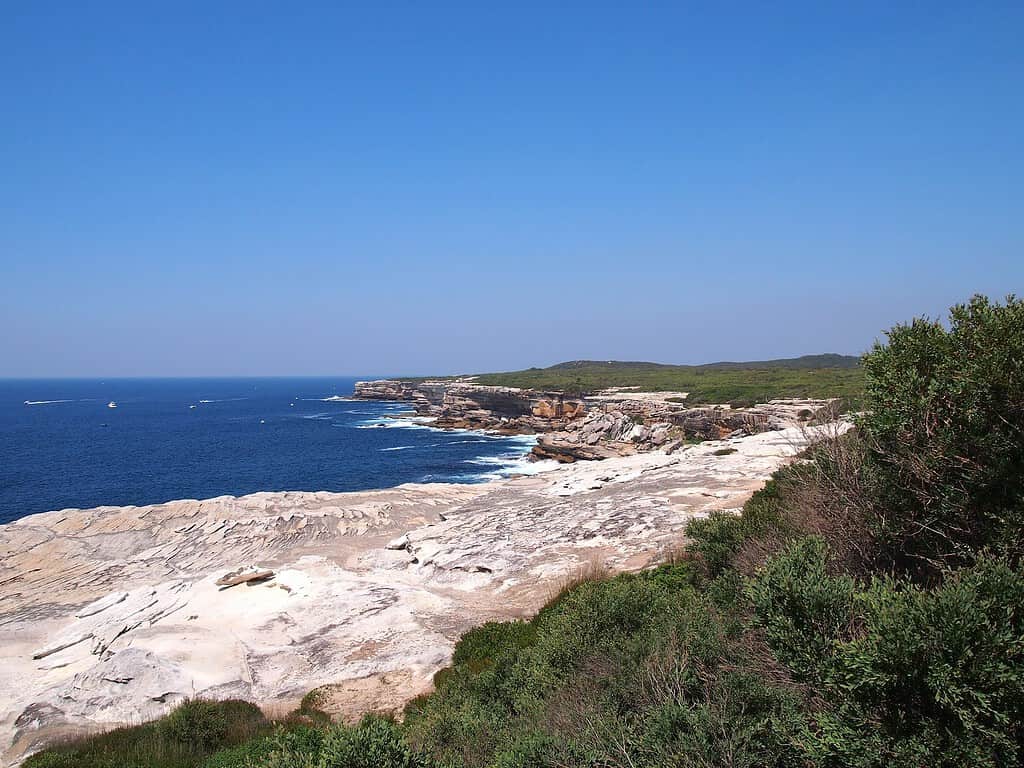
Cape Solander has some of the heaviest wave breaks in Australia.
©Maurice van Creij / CC BY 3.0 – License
This cape is situated on the Kurnell Peninsula, near the southern entrance of Botany Bay, just south of Sydney. It is a rocky headland that juts out into the Tasman Sea, providing a prime location for large swells to converge and create powerful waves. The area is part of Kamay Botany Bay National Park, offering stunning coastal views and a rugged natural landscape.
People regard Cape Solander as one of Australia’s most demanding and heavy wave breaks. The waves here are characterized by their sheer power, speed, and hollow barrels, making it a favorite among experienced and advanced surfers seeking a challenging ride. The wave quality at Cape Solander is exceptional, offering fast and intense waves that can reach impressive heights during large swells.
The best time to surf at Cape Solander is during the winter months (April to September) when the region receives consistent and larger swells from Southern Ocean storms. During this period, the waves at Cape Solander can reach heights exceeding 10 to 15 feet or even more, providing an adrenaline-pumping experience for experienced surfers. However, it’s important to note that conditions at Cape Solander can be unpredictable, and the wave size and quality can vary depending on factors such as tides, wind, and the size and direction of the swell.
Cape Solander is often referred to by its local nickname, “Ours.” The name reflects the reputation of the break as a challenging and often treacherous surf spot. It is a testament to the respect and caution surfers must exercise when facing the heavy waves and powerful undertows at Cape Solander.
5. The Bluff, South Australia
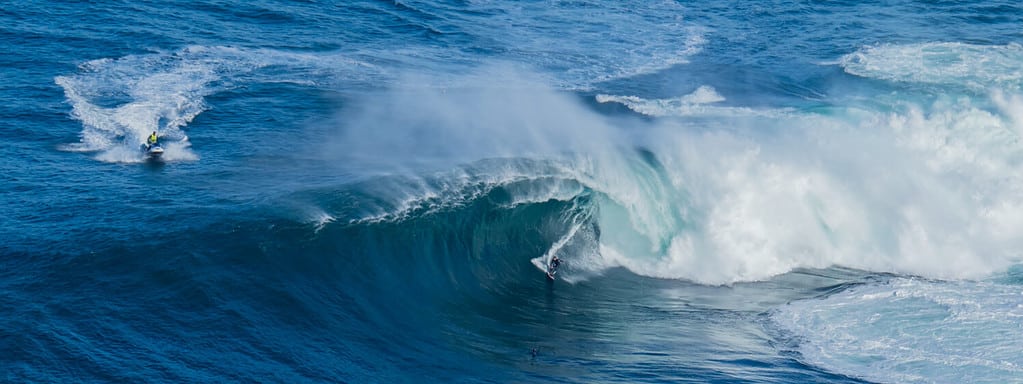
Huge waves at Shipstern Bluff on Tasmania’s southeast coast.
©Joel Everard/Shutterstock.com
The Bluff is situated on the Fleurieu Peninsula, approximately 80 kilometers south of Adelaide, the capital city of South Australia. It is a rocky headland that juts out into the Southern Ocean, offering an exposed coastline that attracts swells from different directions. Stunning coastal cliffs, beautiful beaches, and a scenic natural environment characterize the area surrounding The Bluff.
The Bluff is renowned for producing consistent and powerful waves, making it a popular destination for surfers seeking challenging and adrenaline-pumping rides. The wave quality at The Bluff is exceptional, with the potential to deliver long, fast, and barreling waves. It offers a mix of right and left-hand breaks, providing opportunities for different maneuvers and riding styles.
The Bluff experiences surfable waves throughout the year, with the most favorable conditions prevailing during winter (April to September). Winter swells generated by Southern Ocean storms bring larger and more consistent waves to the region. During these peak swells, the waves at The Bluff can reach impressive heights, typically ranging from 6 to 12 feet or even more, depending on the size and direction of the swell. The wave size and quality can vary depending on factors such as tides, wind, and the specific location along The Bluff.
6. Cactus Beach, South Australia

A surfer enjoying the waves in Cactus Beach, South Australia.
©fboudrias/Shutterstock.com
Cactus Beach is situated along the remote coastline of the Eyre Peninsula, approximately 25 kilometers west of Penong, a small town in South Australia. The beach is located in a secluded area, offering a sense of untouched natural beauty. Access to Cactus Beach requires traveling on unpaved roads, and people recommended having a suitable vehicle for the rough terrain.
Cactus Beach is famous for its powerful and heavy waves, making it a destination that appeals to experienced surfers seeking a significant challenge. The wave quality at Cactus Beach is exceptional, characterized by massive swells, fast-moving walls of water, and hollow barrels. For example, the waves can reach towering heights, often exceeding 20 feet or more during intense swells, creating an awe-inspiring and thrilling surfing experience.
Best time to Surf Cactus Beach
The best time to surf at Cactus Beach is during the winter months (April to September) when the region experiences larger swells generated by Southern Ocean storms. Winter brings consistent waves and the potential for massive swells that produce the colossal waves that people recognize Cactus Beach for. Surf conditions can vary, and it is important to monitor local surf reports, weather conditions, and swell forecasts to determine the optimal time to visit.
One of the unique aspects of Cactus Beach is its remote and isolated nature. The beach is far from major towns and cities, providing a sense of solitude and raw natural beauty. Surfers who venture to Cactus Beach often appreciate the untouched environment and the serenity of vast stretches of coastline.
People consider Cactus Beach as one of the most challenging surf breaks in Australia. The heavy and robust nature of the waves requires surfers to possess advanced skills, experience, and a thorough understanding of ocean safety. People recommended that only experienced and skilled surfers attempt to ride the waves at Cactus Beach due to its demanding conditions.
The Great Barrier Reef
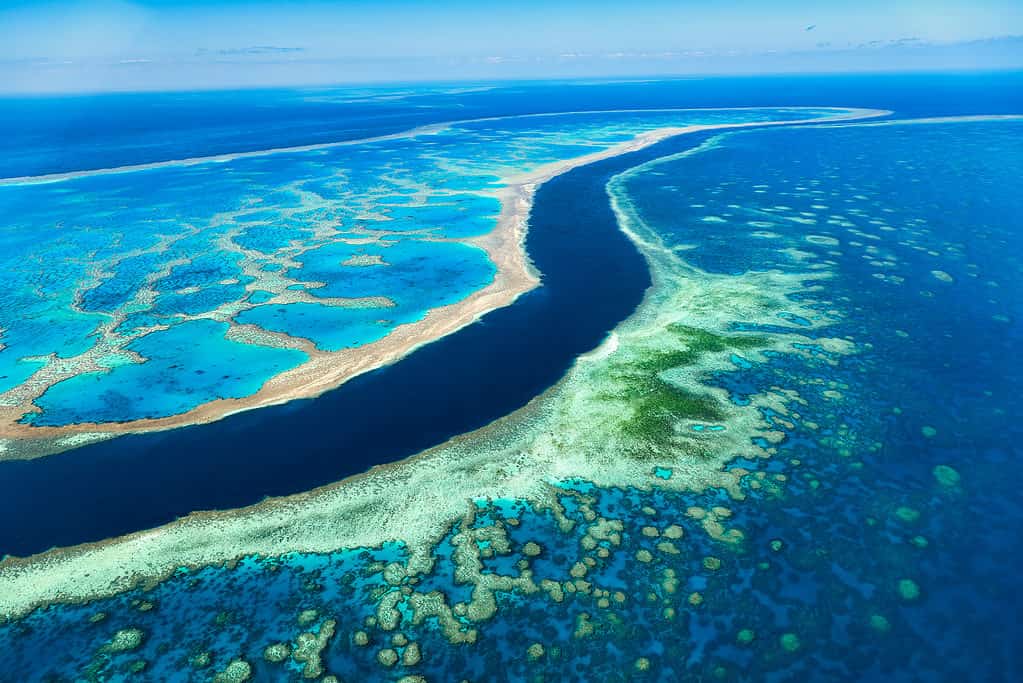
Great Barrier Reef in Queensland, Australia.
©iStock.com/Cavan Images
Australia is renowned for its diverse and vibrant marine life. The surrounding oceans and the Great Barrier Reef contribute to the country’s incredible biodiversity. Here are some fascinating aspects of marine life in Australia:
The Great Barrier Reef is a UNESCO World Heritage site and is one of the world’s most significant ecosystems. Most importantly, it is home to thousands of species, including more than 1,500 species of fish, 600 coral species, and numerous marine mammals, reptiles, and invertebrates.
Sealife in Australia
Whales
Australia offers excellent opportunities for whale watching. The waters off the Australian coastline are frequented by several species of whales. This includes humpback whales, southern right whales, orcas (killer whales), and minke whales. Additionally, the migration of humpback whales along the east coast is particularly remarkable.
Sharks
Australia is known for its diverse shark population. The Great White Shark is a prominent species found along the southern coast. At the same time, the tropical waters of the Great Barrier Reef are home to various shark species. This includes the reef shark and the elusive hammerhead shark.
Dolphins
Dolphins are common in Australian waters, and several species can be encountered along the coastline. The most well-known species is the bottlenose dolphin, known for its playful behavior and intelligence. Visitors often observe dolphins swimming and leaping alongside boats or from the shore.
Sea Turtles
Australia is an important nesting site for several species of sea turtles. This includes the green turtle, loggerhead turtle, hawksbill turtle, and leatherback turtle. The Great Barrier Reef and the Ningaloo Reef are crucial habitats for these ancient reptiles.
Coral and Fish Species
The Great Barrier Reef boasts an astonishing array of coral species. This includes hard corals, soft corals, and vibrant coral gardens. This rich ecosystem provides a habitat for many fish species, including clownfish, parrotfish, angelfish, butterflyfish, and many more.
Fun Facts about Australia
Australia has many unique wildlife, including iconic kangaroos, koalas, wombats, and platypuses. It also has the highest population of camels outside of the Middle East.
The Great Barrier Reef, located off the northeastern coast of Australia, is the largest coral reef system in the world. It stretches over 2,300 kilometers (1,430 miles) and is home to various marine life.
Australia boasts diverse landscapes ranging from vast deserts (like the famous Outback) to lush rainforests. For example, beaches, rugged mountains, and unique rock formations such as Uluru (Ayers Rock) and the Twelve Apostles.
The Indigenous people of Australia, are known as Aboriginal and Torres Strait Islander peoples. They have a rich and ancient culture dating back over 65,000 years. Their art, music, storytelling, and spiritual beliefs are integral to the country’s heritage.
Australia is known for its “big things” – oversized sculptures and structures scattered across the country. Examples include the Big Banana, Big Pineapple, Big Prawn, and Big Koala, among many others.
Australia is a multicultural society, with people worldwide calling it home. Over 200 languages are spoken, and various cultural festivals and cuisines contribute to the vibrant multicultural fabric of the country.
More Fun Facts
Australians are passionate about sports. The most popular include Australian rules football, cricket, rugby (both league and union), soccer, tennis, and swimming. The Melbourne Cup is a prestigious horse race. People recognize it as the “race that stops a nation.
People consider Australia home to incredible wildlife. Some dangerous species include snakes, spiders, and marine creatures. This includes the box jellyfish and saltwater crocodiles you can find in various parts of the country. However, encounters with these animals are relative.
Australia has the world’s sixth-longest coastline, stretching over 25,760 kilometers (16,007 miles). Its numerous beautiful beaches make it a popular destination for beach lovers and surfers.
Vegemite, an iconic Australian food, is made from spread made from yeast extract. It has a unique salty and savory taste. People often enjoyed it on toast or as an ingredient in various dishes. It is a cultural staple and has become synonymous with Australian cuisine.
Summary of the 6 Beaches With the Largest Waves in Australia
| Rank | Beach | Wave Size |
|---|---|---|
| 1 | Bells Beach, Victoria | Can exceed 10 to 15 feet or larger; Largest waves ridden have reached 20 feet or more during intense storms |
| 2 | Margaret River, Western Australia | Can exceed 10 to 15 feet or even larger; Winter generates giant waves exceeding 20 feet in height |
| 3 | Snapper Rocks, Queensland | Can reach average heights of 4 to 6 feet; during peak swells, can exceed 8 to 10 feet or larger |
| 4 | Cape Solander, New South Wales | Can exceed 10 to 15 feet or more |
| 5 | The Bluff, South Australia | Typically ranging from 6 to 12 feet |
| 6 | Cactus Beach, South Australia | often exceeding 20 feet or more during intense swells |
The photo featured at the top of this post is © wasiolka/Shutterstock.com
Thank you for reading! Have some feedback for us? Contact the AZ Animals editorial team.






